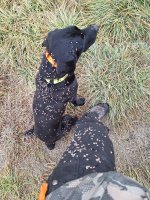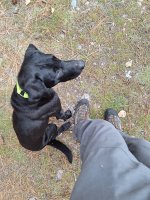You are using an out of date browser. It may not display this or other websites correctly.
You should upgrade or use an alternative browser.
You should upgrade or use an alternative browser.
Dealing with stickers
- Thread starter KansasGsp
- Start date
birddude
Well-known member
Be careful though. I sheared my setter down to nothing once years ago. He felt great but laid out in the sun and got sunburned. I felt terrible.There's only one good remedy for burs. SHEARS!
AtTheMurph
Well-known member
I'm in the exact same boat. Brittany after having 3 short haired dogs. Burrs and stickers suck.
I went on Amazon and bought a battery hair clipper. told the wife, who also loves the dogs longer hair, that he was too hot running around and might have heat stroke and shaved his hair off so he looks like a little orange and roan shorthair-ish breed. He actually likes when I cut his hair off and will just lay there enjoying the experience.
It helps immensely with the burrs and stickers.
I went on Amazon and bought a battery hair clipper. told the wife, who also loves the dogs longer hair, that he was too hot running around and might have heat stroke and shaved his hair off so he looks like a little orange and roan shorthair-ish breed. He actually likes when I cut his hair off and will just lay there enjoying the experience.
It helps immensely with the burrs and stickers.
Springer22
Well-known member
My springer tries to nip me too. She hates it. Only the ears get bad on her though. No problem with the rest of her coat.Oh my gosh, no kidding! So tender there! Ace acts like I'm killing him. And he has actually tried to nip me. He HATES having cockle burrs removed from his arm pits. It must really, really hurt. If he gets them there, I apply a bunch of coconut oil, which doesn't make them just fall out, but helps quite a bit.
They finally got so bad I had someone shave the ears, ( put a muzzle on) and I may never go back. Was in some thick nasty stuff today and not one burr or anything, game changer!
Limitless
Well-known member
I used to shave my springer's ears down very short before season too (along with armpits, pants, and tail). That was after a few years of battling the cockleburs. Soooo much better.My springer tries to nip me too. She hates it. Only the ears get bad on her though. No problem with the rest of her coat.
They finally got so bad I had someone shave the ears, ( put a muzzle on) and I may never go back. Was in some thick nasty stuff today and not one burr or anything, game changer!
Gatzby
Well-known member
Yup x2In my area beggars-tick and hounds-tongue are the worst.
With the lab, at the end of the hunt a quick swim and the towel off gets most of these.
I had to pull a couple burrs off one dogs tail yesterday, I guess there is a first time for everything
Tomahawker
Well-known member
Early on I would de burr my Setter that evening after a hunt. No more. I’ll wait till the next day and be amazed at what she can get out herself. Then clean up what’s left. Arm pits ears etc.
BritChaser
Well-known member
Seize the pup and trim lol. Those feathers will grow back in no time - that's what you tell "she who must be obeyed" as Rumpole called Hilda.
I thought I was the only guy listening to the wife about springer trims…..the good news is he’s got such a high motor he has to get a pound of cholla in his grape to slow him down the bad news he collects every burr and thorn known in the region and at the end of every of hunting day he flops down rolls on belly and asks me to get to work….
Some helpful hints here and I will sure put em to use.
My chessie is so greasy the only place he burrs up is between his toes ( he gets no baths after August and he’s pretty rank about now) and I never thought about it as a burr resistor, just water proofing….live and learn
Some helpful hints here and I will sure put em to use.
My chessie is so greasy the only place he burrs up is between his toes ( he gets no baths after August and he’s pretty rank about now) and I never thought about it as a burr resistor, just water proofing….live and learn


